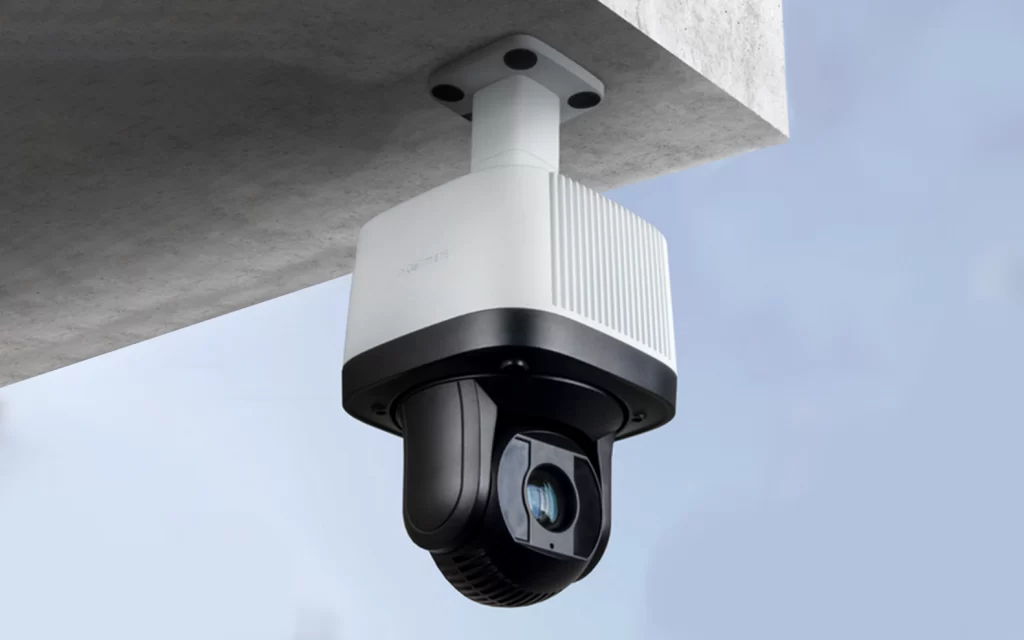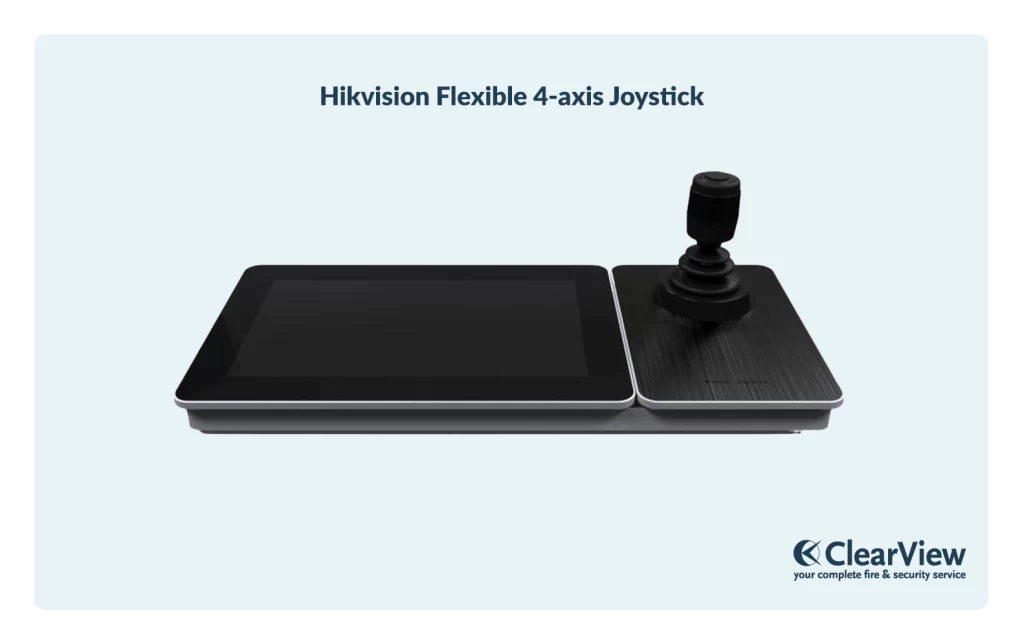PTZ CCTV cameras are advanced surveillance tools known for their versatility and superior capabilities compared to fixed-position cameras. These cameras can pan horizontally and vertically, offering a wide field of view without physical repositioning, making them ideal for continuous monitoring of large spaces like outside car parks or large warehouses and buildings.
Some advanced PTZ cameras are equipped with intelligent features, such as facial recognition and automatic tracking of objects. This means they can not only pan, tilt, and zoom, but they can also identify and follow specific individuals or objects within their field of view. It’s like having a robotic assistant in your surveillance system that can autonomously focus on interesting or potentially suspicious activities.
In this article, we will discover what sets them apart from normal CCTV cameras and leave you with everything you need to know about PTZ Cameras.
Features & Functionality
Choosing between a Pan-Tilt-Zoom camera and a normal CCTV camera depends on your specific surveillance needs. Here are some reasons why you might opt for a PTZ camera over a traditional CCTV camera:
Versatility: PTZ cameras offer pan, tilt, and zoom functionalities, providing a wider range of coverage compared to fixed-position CCTV cameras. This versatility allows you to monitor different areas without the need for multiple cameras.
Wide Area Coverage: These cameras are particularly useful for monitoring large and open spaces, such as parking lots, stadiums, or expansive outdoor areas, where a fixed CCTV camera might have limitations.
Zoom Capabilities: The optical zoom feature allows you to magnify details without sacrificing image quality. This is crucial for identifying faces, capturing licence plate details, or monitoring specific points of interest over long distances.
Remote Operation: They can be operated remotely, enabling real-time adjustments by security personnel without the need for physical presence at the camera’s location. This can be useful for tracking moving objects or adjusting the focus on specific areas of interest.
Reduced Camera Count: In certain scenarios, a single PTZ camera can replace the need for multiple fixed cameras. This can be more cost-effective in terms of equipment and installation costs.
Motion Tracking: Some PTZ cameras come with auto-tracking features, allowing them to follow and focus on moving objects or individuals within their field of view. This is beneficial for dynamic surveillance situations.
Dynamic Surveillance: They provide dynamic surveillance capabilities, making them suitable for scenarios where the monitoring requirements change frequently.
Integration with Larger Systems: They can be integrated into larger surveillance systems, working in conjunction with fixed cameras to provide comprehensive coverage and detailed monitoring.
However, it’s important to note that PTZ cameras also have some limitations, such as a higher cost, mechanical complexity, and potential issues with lag during movement. The choice between a PTZ camera and a normal CCTV camera should be based on a careful assessment of your specific surveillance requirements and the features that align with your security goals.
Pros & Cons of a PTZ Camera
Pros
- Versatility: They offer pan, tilt, and zoom functionalities, providing flexibility to monitor a wide range of areas and adjust the focus as needed.
- Wide Coverage: The ability to pan and tilt allows for monitoring large areas, making them suitable for expansive spaces like outdoor environments or large warehouses and buildings.
- Zoom Capabilities: Optical zoom allows for magnification without compromising image quality, aiding in detailed surveillance over long distances.
- Remote Operation: They can be operated remotely, enabling real-time adjustments without physical presence. This is particularly useful for security personnel.
- Motion Tracking: Some PTZ cameras come with auto-tracking features, allowing them to follow and focus on moving objects or individuals within their field of view.
- Reduced Camera Count: In certain situations, a PTZ camera can replace multiple fixed cameras, potentially reducing overall system costs.
Cons
- Cost: PTZ cameras are generally more expensive than fixed cameras due to their advanced features and mechanical components. (Depending on their features, they can cost anything from £140 all the way upwards of £4,000)
- Complexity: The added functionalities make PTZ cameras more complex, requiring skilled professionals for installation, setup, and maintenance.
- Vulnerable During Movement: When the camera is in motion, it may not capture details effectively, and there can be a brief lag as it adjusts its position.
- Potential Mechanical Issues: Being mechanical devices, PTZ cameras may experience wear and tear over time, potentially leading to mechanical failures or malfunctions.
- Dependency on Power and Connectivity: They require a stable power source and connectivity for remote operation. Power outages or network issues can impact their functionality.
Ultimately, the decision to use PTZ cameras depends on the specific surveillance requirements and budget constraints of a given situation.

Applications and Uses
PTZ cameras are versatile surveillance tools with a range of applications. Let’s have a look at some common uses:
Retail Environments: They are utilised in retail settings to monitor store entrances, exits, and overall security. Their ability to zoom in on specific areas helps prevent theft or monitor customer behaviour.
Industrial Facilities: In industrial environments, they can be strategically placed to monitor critical areas of production processes or to track the movement of goods within a facility.
Security and Surveillance: They are widely used for security purposes in various settings, including businesses, government facilities, and residential areas. Their ability to pan, tilt, and zoom allows for dynamic surveillance of different zones.
Wide Area Monitoring: They are ideal for monitoring large areas, such as large car parks, stadiums, or outdoor spaces, where a single fixed camera might not provide sufficient coverage.
Live Event Coverage: They are commonly employed to cover live events, such as sports games, concerts, or conferences. Operators can adjust the camera to focus on specific activities or areas of interest.
Traffic Monitoring: They are used to monitor traffic flow and enforce traffic regulations. They can zoom in to capture licence plate details and monitor intersections for improved public safety.
Remote Surveillance: They can be operated remotely, making them suitable for locations where physical access is limited. Security personnel can control and monitor the cameras from a centralised location.
Border Security: These cameras are employed in border security to monitor and surveil vast areas. Their ability to cover long distances and zoom in on specific points aids in border patrolling and surveillance.
Critical Infrastructure Protection: They are used to safeguard critical infrastructure such as power plants, water treatment facilities, or communication hubs by providing enhanced surveillance and control capabilities.

Final Thoughts
PTZ (Pan-Tilt-Zoom) CCTV camera systems have emerged as powerful and adaptable tools in the realm of surveillance. Their pan, tilt, and zoom functionalities offer a dynamic range of coverage, making them suitable for a variety of environments and applications. From expansive outdoor spaces to critical infrastructure, these systems provide advanced capabilities that go beyond traditional fixed-position cameras.
The versatility of these cameras, coupled with features like optical zoom and remote operation, positions them as valuable assets for enhancing security and situational awareness. Whether deployed in city surveillance, commercial establishments, industrial facilities, or residential areas, PTZ CCTV cameras excel in offering comprehensive and responsive surveillance solutions.
Despite their advantages, it’s essential to acknowledge potential considerations, such as cost, complexity, and the need for skilled installation. Striking a balance between the specific surveillance needs and the capabilities of PTZ camera systems is crucial to maximising their effectiveness.
As technology continues to advance, the future of PTZ CCTV cameras holds promise for even more sophisticated features, integration with emerging technologies, and enhanced adaptability. In a world where security demands are ever-evolving, PTZ CCTV camera systems stand at the forefront, ready to meet the challenges of tomorrow.
Useful Resources
Frequently Asked Questions
A PTZ CCTV camera, also known as a PTZ camera, is a surveillance camera with Pan-Tilt-Zoom capabilities. It can pan horizontally, tilt vertically, and zoom in or out, providing a versatile range of coverage.
They are commonly used in various environments, including city surveillance, commercial establishments, industrial facilities, transportation hubs, and residential areas, due to their adaptability and advanced surveillance features.
They typically have optical zoom capabilities, allowing users to magnify or reduce the size of the image without compromising image quality. This is achieved by adjusting the focal length of the camera lens.
Yes, they can be operated remotely. Security personnel can control the camera’s pan, tilt, and zoom functions either manually or through automated pre-set patterns or tracking algorithms.
While they can be installed by professionals, some models are designed for easy installation and may be set up by individuals with basic technical skills. Professional installation is recommended for optimal performance.
Many cameras designed for outdoor use are weatherproof and come with an Ingress Protection (IP) rating, indicating their resistance to dust and water. This makes them suitable for withstanding various weather conditions.